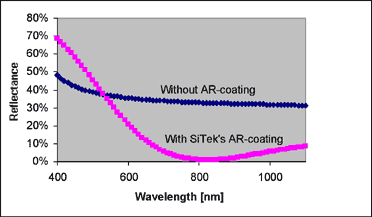AR-Coating
Introduction:
Whenever light hits the boundary between two media, some or all of the light may be reflected. The amount of reflected light is dependent of the reflective indices of the media and the wavelength of the light. The incident angle of the light also influences the reflection.
To have a good responsivity of the PSD it is important that as much of the incident light as possible is transmitted into the detector and not reflected away from the surface. The reflection at a boundary between air and silicon is above 32% of the incident light. Depositing an efficient anti-reflection (AR) coating on the PSDs surface can dramatically reduce this figure.
Basic principles of AR-coating:
The simplest anti-reflective coating consists of a thin layer (AR-layer) of some material that has a reflective index somewhere between air and the silicon. The incident light will then undergo reflections both in the air/AR boundary and the AR/silicon boundary. If the thickness of the AR-layer is properly chosen a destructive interference between the two reflected waves will occur which will decrease the reflected wave.
The interference in the AR-layer is governed by the Fresnel's equations which states that if the refractive index of the applied AR coating equals the square root of the product of the indexes for air and silicon all of the reflection may be extinguished.
It is often problematic to find an appropriate material for the AR-layer that fulfils this condition. Often two, three or more layers with different reflective indices are combined to get as near as possible to the ideal situation of zero reflected light.
SiTek's AR-coating:
SiTek has a two-layer AR-coating that is optimized for wavelengths around 860 nm. Thanks to this the reflectance is decreased from 32% to less than 2% for the selected region. This is pictured in the chart below. The wavelength for which the minimum reflection occurs can be selected by adjusting the thickness of the AR-coating layers. If the detectors are going to be used in applications where the incident angle of the light is not normal to the surface this has to be taken into consideration when developing the optimal AR-coating.
For applications where the responsivity is a limiting factor it is of course of paramount interest to do an optimization of the AR-coating. Of course, SiTek can adjust the AR-coating after your specific needs.

Figure: A comparison between the reflectance with and without AR-coating. It is very obvious that SiTek's AR-coating dramatically decreases the reflectance and consequently increases the responsivity.
If you need any further information please contact us directly.
